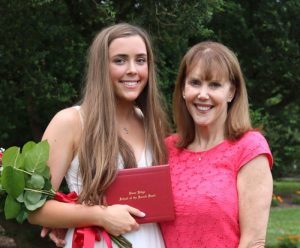
When Cate Willing has questions about public health issues, she can consult with any of her professors at Syracuse University, where she’s studying public health at Falk College and policy studies at the Maxwell School and the College of Arts and Sciences. But since her sophomore year on campus was cut short by the novel coronavirus pandemic, she’s been consulting with another knowledgeable source at her home in McLean, Virginia: Jayne O’Donnell, her mother. O’Donnell is the health care policy reporter for USA Today. She is also an author, TV contributor, freelance writer, and co-founder of the Urban Health Media Project, which trains high school students to report on health and social issues that are often overlooked in marginalized communities.
“It has all been surreal,” Willing says about the pandemic that forced Syracuse University to end on-campus classes, send students home and transition to online teaching and learning. “We were following the virus overseas and not feeling the direct impact on people and their lives, and then within a month we’re all home in isolation. I think my friends and I assumed that we would be out of school for three weeks or so and then return to finish the semester on campus.”
Technology allows life to remain manageable, both academically and socially. “Completing my classes online isn’t easier or more difficult, it’s just different,” Willing says. “None of my classes are conducted in Zoom. Instead, my professors have recorded their voices talking over PowerPoints. I prefer that because they are all stored for constant access through Blackboard. I’m keeping up with my friends from school, too. We text and FaceTime almost daily.”
An Informed Perspective
Being a public health major helped Willing readily grasp the significance of the pandemic. “I understood more about how viruses spread, and my classes have covered the travel warnings that are implemented in a pandemic, so I was able to decode those fairly well,” Willing says. “I think that my generation has shifted from kind of dismissing the virus to now following regulations and practicing social distancing rigorously. I was getting a lot of information from my mother, who was reporting on it, and that combined with my public health background made it seem more serious from the start.”
Willing imagines her future options as a public health professional. “If I were to play a role in combatting the pandemic, it would be to help those who are struggling through isolation and make a plan for when the social distancing is over,” she says. “How can we best acclimate to the world we will meet on the other side of this pandemic?”
Willing’s mother also believes that the major fallout from the pandemic will be from issues surrounding mental health. “My biggest fear is how it’s going to compound all the other public health problems I’ve been writing about, like mental illness, isolation, loneliness, addiction, child abuse and domestic violence,” O’Donnell says. “I moderated a webinar with NYU global health professors recently, and we talked about what an important field public health is right now. It’s going to be a growth field. Cate’s curriculum at Syracuse University is great, and I like the program’s strong focus on community solutions to public health issues.”
Expanding Learning Opportunities
In addition to mirroring her mother’s interest in public health, Willing also works hard to communicate public health issues to her community at Syracuse University. She’s found the perfect vehicle for that pursuit at Falk College. During their first semester at Syracuse University, many public health students take a Healthy You Practicum (PHP 227) under the direction of Falk professor of practice Luvenia Cowart. The one-credit class introduces them to Healthy You, a health news magazine published by the students themselves to promote healthier behaviors on campus and in the community. A partnership of the Falk College public health program and the Division of Student Affairs, the magazine embraces cross-campus collaboration by also serving students at other higher education institutions in Central New York. The students explore topics and develop skills in magazine writing, illustration, photography, and layout and design.
“I was editor-in-chief of my high school’s newspaper, so I reached out to Professor Cowart to express my interest,” Willing says. “I wrote for the magazine my freshman year, became copy editor and now I am student managing editor. I’ve been working with her in the classroom this year, teaching journalistic writing and conducting topic selection for the articles. As the magazine’s sole student editor, I meet with student writers to go over their articles and prepare them for publication.” Classroom instruction runs for six weeks and then transitions to online communication with the students, so there’s been little disruption during the pandemic. “Cate is an absolute perfect fit as a role model for students interested in exploring their health-writing abilities and developing leadership skills,” Cowart says.
Cowart believes that offering Willing the student managing editor position was one of her best administrative decisions ever. “A critical thinker, she is focused and well-rounded as she engages the student editorial board and faculty and staff campus collaborators. Her visionary perspective, creativity and initiative make an invaluable contribution to the planning, development and production processes of the newsmagazine,” Cowart says. “Cate was born to lead.”
